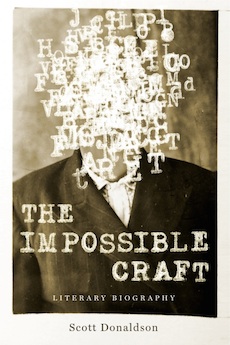By David Madden
Leon Edel, author of the celebrated five-volume biography of Henry James, opens a door to Scott Donaldson’s The Impossible Craft, saying, biography “is a noble and adventurous art… A biographer fashions a man or a woman out of the seemingly intractable materials of archives, diaries, documents, dreams, a glimpse, a series of memories.”
Following a brief, cogent historical background to the art of biography, Donaldson (ФВК, William & Mary, 1996) tells how he journeyed into becoming one himself, first taking on the minor poet Winfield Townley Scott. He sought advice from prominent biographer Justin Kaplan, who said that the biography needed “some slowing down, building up, refocusing.” Donaldson tells us that “editorial guidance of such sophistication was rare at that time (the early 1970s).” He is eager to credit the excellent editing of his biographies of Hemingway, Fitzgerald, Cheever, Edwin Arlington Robinson, MacLeish, and of his Yale professor Charlie Fenton, Robert Loomis’ editing at Random House, Peter Davison’s at Houghton Mifflin, and Malcolm Cowley’s at Viking, among others.
About writers compared with other subjects of biographies, Donaldson makes many trenchant observations. “Almost all major American writers have had dominant mothers and ineffectual fathers.” Katherine Anne Porter, Lillian Hellman, James Dickey are among the “extravagant liars” no biographer can trust as a source about themselves or fellow writers. “The best writers are liars,” said Hemingway. Earl Rovit, early Hemingway scholar, has said that most authors “find ways of distancing themselves from naked exposure with elaborate masks, stylistic convolutions, displacements and condensations, invented diversions and detours.”
Biographers should not lie, cheat, or steal, but relying mainly on facts, they may, in moderation, employ intuition, imagination, and the techniques of fiction. They should not notoriously practice exclusive claim to their research findings about their subjects, as Donaldson learned in his conflict with Matthew Bruccoli regarding Fitzgerald.
Biographers do well to strive to avoid identifying too closely with their subjects; avoid writing out of enmity; and avoid getting too involved with the family members. Readers do well to be mindful of the fact that just as no one can really know oneself, that no one is truly known to others, and that every biography is to some extent a biography of the biographer, as Tomasso Landolfi showed in his unique story “Gogol’s Wife.” After the biographer dumps the results of research at the reader’s front door, the final task of constructing the biography is the reader’s.
Donaldson’s description of Archibald MacLeigh’s narcissism and his public life is especially informative. I take issue with the dictum Donaldson and other biographers strive to obey in situating the subject in the cultural, political, and intellectual history of his time. Too often the result is prolonged and repeated diversions and distractions from the immediate present of the subject’s life. I suggest bringing to bear MacLeish’s declaration, “A poem should not mean/ But be.”
As he wrote the dual biographies of Hemingway and Fitzgerald, Donaldson’s goal was “to achieve an understanding of the initial friendship between these two great writers, its eventual collapse, and what that had to tell us about them and their work.” My own conviction as a novelist and a biographer is that the work is the writer.
Donaldson takes up the problems of using sources, such as letters and interviews. He examines ethical issues and a list of things a biographer cannot achieve. No wonder the ideal biographer is a myth. “And yet…” is the title of a section in which he argues well that the burdensome life and the strenuous work of the literary biographer is exquisitely and enthrallingly worthwhile.
Quoting many famous biographers, Donaldson compares fiction writers and historians with many types of biographers, and he enumerates various wrong-headed types of literary biography. Virginia Woolf considered “biography the most restricted of all the arts.”
Like the novelist, the biographer is a storyteller but cannot make things up. I wish Donaldson had dealt with the question whether the autobiographer may legitimately be unreliable. A substantial comparison between the nature and the practice of biography and autobiography, along with speculations about innovative possibilities in style and craft, would have enhanced Donaldson’s stories and insights about biography.
Donaldson concludes his excellent tale of the making of many biographies, those of other as well as his own, with four long, detailed “Case Studies.” He describes his difficulties in telling the story of the neglected master poet Edwin Arlington Robinson, who was “very much a revolutionary.” The “fight over the poet’s bones” was harrowing. He examines the facts and fantasies about Zelda Fitzgerald’s fabled affair with a French pilot in the summer 1924. Hemingway’s battles with biographers during the years 1949-54 express yet another perspective on the impossible craft.
The most absorbing case is that of “the Cheever misadventure,” involving very stressful encounters with Mary Cheever and lawsuits. He conducts a critical analysis of previous and later Cheever biographies and describes the conflicts the authors had with member of the family.
Books about the nature and practice of biography are rare. As such, this eminently readable and important book by a stellar biographer is uniquely instructive.
David Madden (ΦBK, University of Tennessee, 1979) has finished an innovative biography of James M. Cain. He has published 14 works of fiction, including the forthcoming Marble Goddesses and Mortal Flesh, and is finishing a memoir, “My Intellectual Life in the Army.”




